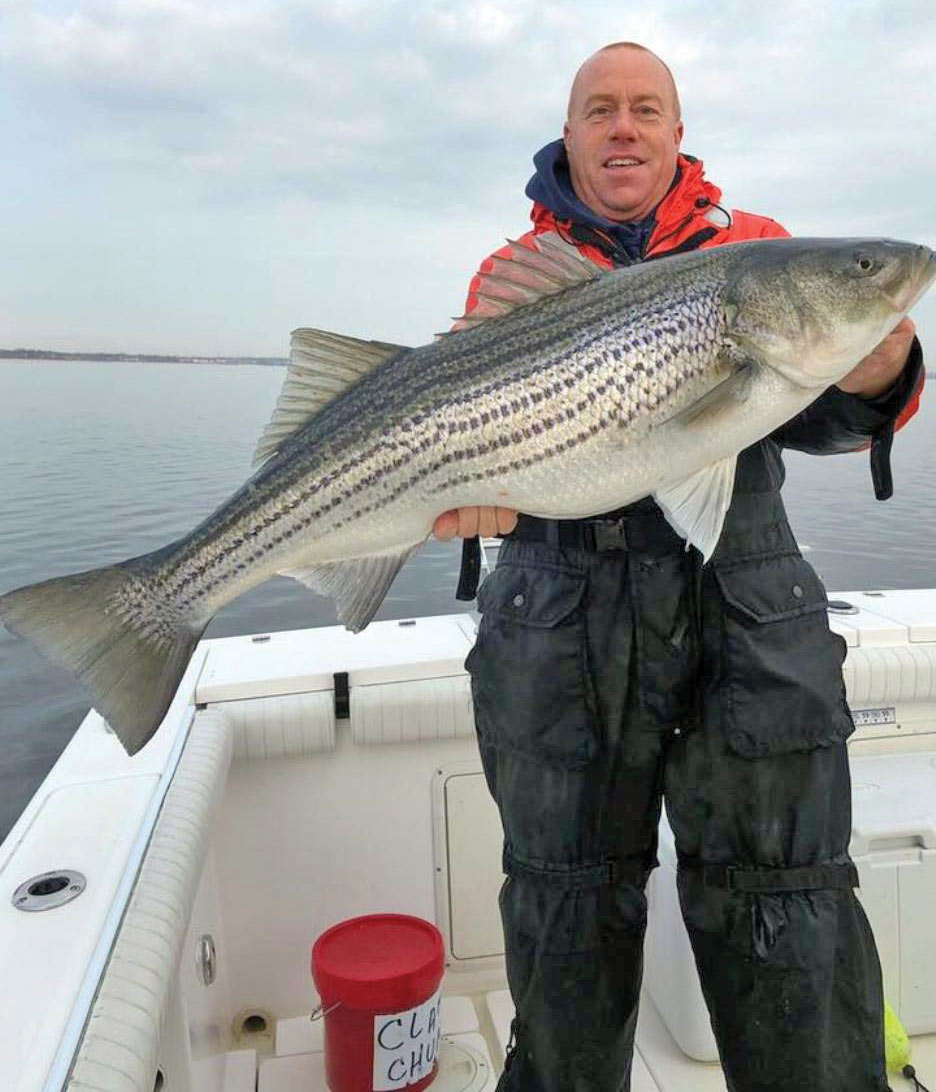
Prints available at
[email protected]
The latest stock assessment states that the stock is in a state of decline and it will continue to decline unless something is done to reverse that trend.
We are hearing rumblings that the striped bass stock is crashing to the point it was back in the ‘70s and that the only way the fishery can be saved is with a total moratorium similar to the one imposed back in the late ‘80s. There is also talk of the fishery being as healthy as ever from some quarters. According to the latest data, both sides are way off base. The reality is that there are still millions of fish in the biomass. Most of them are small, while the numbers of larger fish have been significantly reduced.
Recent research and data should help provide a better understanding of the current state of the fishery, and where we are headed in regard to the management of Atlantic striped bass in the foreseeable future. Most of those who have fished for striped bass over the past 20 years have seen a decline in their striper catches over the past decade, with the most significant decline occurring over the past five to seven years. The good news is that the science has finally caught up to the anecdotal evidence that many anglers have been experiencing.
A Benchmark Stock Assessment for the Atlantic striped bass was prepared by the Atlantic States Marine Fisheries Commission (ASMFC) during 2018 and submitted for peer review in November 2018. The ASMFC Striped Bass Board recently met on February 6 in Virginia to discuss this latest stock assessment even though the Stock Assessment Report (SAR) had not yet been approved due to the federal government shutdown. The draft SAR says that the stock is in a state of decline and it will continue to decline unless something is done to reverse that trend.Robert E. Beal, Executive Director of the Atlantic States Marine Fisheries Commission (ASMFC) noted,“The Striped Bass Management Board reviewed the preliminary results of the benchmark stock assessment and expressed significant concerns over the continued decline in spawning stock biomass. The Board tasked the Striped Bass Technical Committee to report back on the reductions needed to end overfishing of this important stock. The Board will review the Technical Committee advice and the final benchmark information at its May meeting and decide the timing and approach that will be used to end overfishing and initiate rebuilding of this resource.” The technical aspects of the results of the latest draft SAR are that the stock is overfished and overfishing is occurring. These are two very different things and I will explain the difference.
Overfishing is simply when the amount of fish being removed from the biomass is more than the number of new fish being recruited into the biomass. The second issue, the SAR states, is that the spawning stock biomass (SSB) is overfished. A stock that is overfished is when the biomass has fallen below the stock threshold. What is threshold? It is the minimum number of fish that the SSB cannot fall below without managers having to take action to rebuild the SSB back to the target level. Threshold and target are the two biological reference points (BRP) which any fishery management plan (FMP) uses to determine the health of a stock. Now that we understand what the draft SAR stated let’s get into the issues facing the 16 voting members of the Striped Bass Board.
Some of the southern stateshave proposed that the current BRPs should be reduced so that no changes to harvest levels would be required. This would do absolutely nothing to rebuild the SSB and would in fact go further towards reducing the overall stock and the SSB. Most of those involved in the management of striped bass believe that current BRPs should be maintained at their present level and that the Board should take whatever action is necessary to rebuild the total stock and the SSB back to levels experienced during the early 2000s as fast as possible.

Another issue that has surfaced over the past several years has to do with the Chesapeake Bay states looking to reduce the minimum size limit of stripers back to 18 inches, which would further hinder rebuildingof the stock. The 2011 year class from the Chesapeake was supposed to be one of the highest successful spawning years of stripers in the past 30 years,yet they really haven’t materialized along the coast. Those fish should range from 26 to 32 inches by now and be playing a large role in the coastal fishery. That obviously has not happened so what happened to this huge number of small stripers we should have seen the last two seasons? While we have seen some of thesefish in the coastal fishery over the past season or two, they have not been present in anywhere near the numbers of fish we should have seen. Many believe the Chesapeake Bay fishery has removed them before they could grow and move into the coastal fishery (Striped bass move into the Coastal fishery somewhere around 24 inches.).
Getting back to the proceedings that took place at the Board meeting on February 6, there were some folks that were looking to poke holes in the data that the draft SAR was based upon. Every time a question was posed to find fault with the draft SAR data set, there was a concise scientific answer that backed it up and made the data look better than those asking the questions would have liked. That was good news from a conservation point of view, and it did appear that the folks from the Chesapeake Bay Region were the ones looking to make a case for faulty data.
As the meeting was winding down only one motion was made. That motion was to task the Technical Committee with preparing a report to be submitted to the Board at their May meeting. This report will outline at least one set of proposed options that would allow the SSB to rebuild to the target level set in the latest fishery management plan. These options could include a reduction in season or increased minimum size limits as well as going to coast-wide measures for both recreational and commercial striped bass harvest. It is likely that many folks will not be happy with the reductions we will all have to accept to rebuild the stock back up to levels seen in the early 2000s. Some board members have implied that increasing the coastal minimum size limit to at least 32 inches,reducing the length of season,and going to a one fish bag limit coastwide might be needed to achieve the required harvest reductions. Some of those also believe that a harvest reduction in the Chesapeake Bay system should be part of the rebuilding plan, which will be the toughest nut to crack in this whole scenario. “We know it is going to be pretty drastic,” said John Clark of the Delaware Division of Fish and Wildlife, a member of the Striped Bass Board.These changes would all be directed at the recreational sector, but reductions in the commercial sector will be necessary as well.
The Board will hold their next meeting in May 2019. It is expected that the draft Stock Assessment will be approved at this meeting and the process to prepare a new FMP Addendum to get the striper stock rebuilt will move forward.
Editor’s Note: The author is a member of New York State’s Marine Resources Advisory Council.




